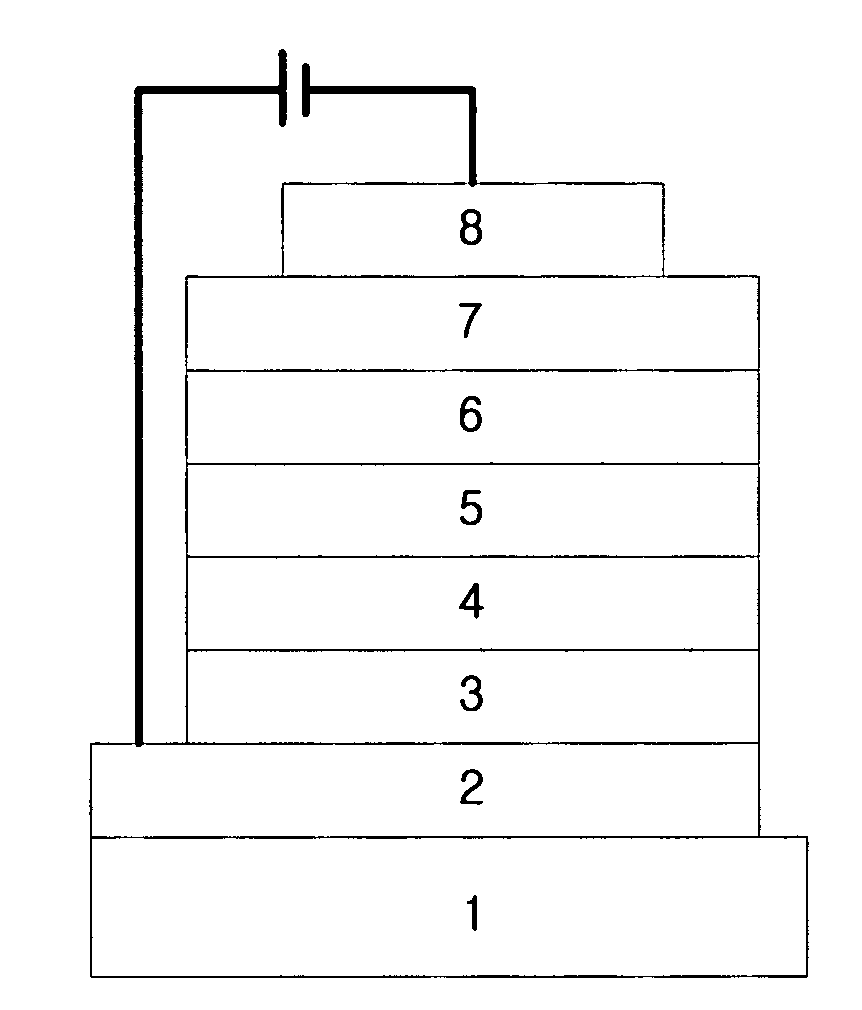Novel organic electroluminescent compounds and organic electroluminescent device using the same
a technology of which is applied in the field of new organic electroluminescent compounds and organic electroluminescent devices, can solve the problems of difficult application of materials to display of high quality, urgent research and development of such materials, and merely a few thousand hours of life. , to achieve the effect of excellent luminous efficiency and improved lifetim
- Summary
- Abstract
- Description
- Claims
- Application Information
AI Technical Summary
Benefits of technology
Problems solved by technology
Method used
Image
Examples
preparation examples
Preparation Example 1
Preparation of Compound (154)
[0096]
[0097]Preparation of Compound (A)
[0098]A reaction vessel was charged with 2,7-dibromofluorene (30.2 g, 100 mmol) and potassium hydroxide (45 g, 80 mmol). After drying under reduced pressure, the vessel was filled with nitrogen gas. Dimethylsulfoxide (550 mL) was added thereto, and the resultant mixture was stirred for 30 minutes. After 30 minutes, water was added thereto in a double water boiler. Iodomethane (57 g, 400 mmol) was slowly added, and the mixture was stirred for 14 hours. The reaction mixture was washed with water (300 mL), and extracted with dichloromethane (300 mL). The extract was dried over anhydrous magnesium sulfate, filtered and concentrated. Recrystallization from methanol (500 mL) gave the target compound (Compound A) (30 g, 85.21 mmol).
[0099]Preparation of Compound (B)
[0100]Compound (A) (20.0 g, 56.81 mmol) thus obtained was dissolved in tetrahydrofuran (1000 mL), and the solution was chilled to −78° C. T...
example 1
Manufacture of OLED's By Using the Organic Electroluminescent Compound of the Invention
[0110]An OLED device was manufactured by using an electroluminescent material according to the invention.
[0111]First, a transparent electrode ITO thin film (15 Ω / □) (2) prepared from glass for OLED (1) (manufactured by Samsung-Corning) was subjected to ultrasonic washing with trichloroethylene, acetone, ethanol and distilled water, sequentially, and stored in isopropanol before use.
[0112]Then, an ITO substrate was equipped in a substrate folder of a vacuum vapor-deposit device, and 4,4′,4″-tris(N,N-(2-naphthyl)-phenylamino)triphenylamine (2-TNATA) (of which the structure is shown below) was placed in a cell of the vacuum vapor-deposit device, which was then ventilated up to 10−6 torr of vacuum in the chamber. Electric current was applied to the cell to evaporate 2-TNATA, thereby providing vapor-deposit of a hole injecting layer (3) having 60 nm of thickness on the ITO substrate.
[0113]Then, to anot...
example 2
Electroluminescent Properties of OLED's Manufactured
[0119]The luminous efficiencies of the OLED's comprising the organic electroluminescent compounds according to the present invention (Example 1) or conventional electroluminescent compound (Comparative Example 1) were measured at 1,000 cd / m2, respectively, and the results are shown in Table 2.
TABLE 2LuminousDopingefficiencyconcentration(cd / A)No.HostDopant(wt %)@ 1,000 cd / m2Color1H-28173.07.5Blue2H-36723.07.4Blue3H-381323.07.0Blue4H-501653.07.9Blue5H-663893.08.3Blue6H-774733.07.5Blue7H-796013.07.6Blue8H-826573.07.8BlueComp.DNACompound A3.07.3Jade1green
[0120]As can be seen from Table 2, the blue electroluminescent devices employing the material according to the present invention showed improved luminous efficiency as compared that of Comparative Example 1. Compound (H-66) with 3.0 wt % doping of Compound (389) showed the highest luminous efficiency.
[0121]Accordingly, the organic electroluminescent compounds according to the present i...
PUM
 Login to View More
Login to View More Abstract
Description
Claims
Application Information
 Login to View More
Login to View More - R&D
- Intellectual Property
- Life Sciences
- Materials
- Tech Scout
- Unparalleled Data Quality
- Higher Quality Content
- 60% Fewer Hallucinations
Browse by: Latest US Patents, China's latest patents, Technical Efficacy Thesaurus, Application Domain, Technology Topic, Popular Technical Reports.
© 2025 PatSnap. All rights reserved.Legal|Privacy policy|Modern Slavery Act Transparency Statement|Sitemap|About US| Contact US: help@patsnap.com



